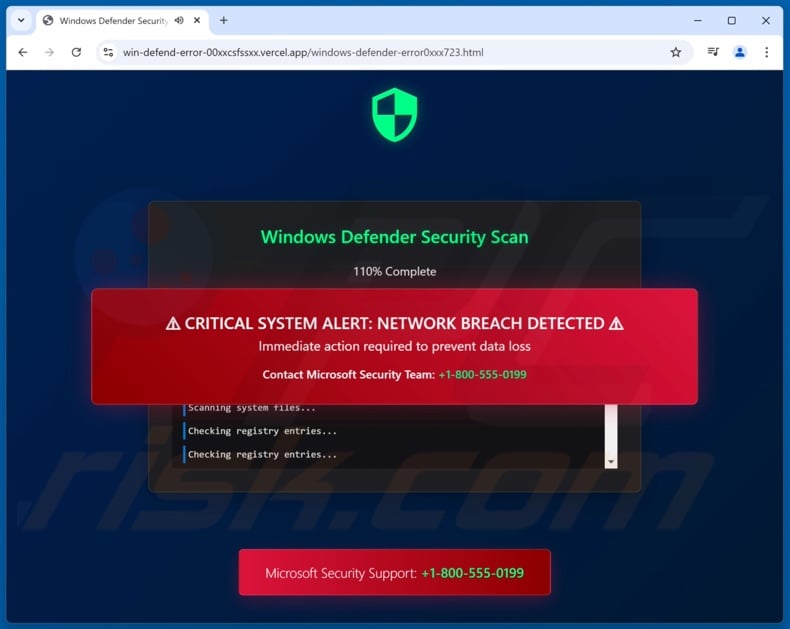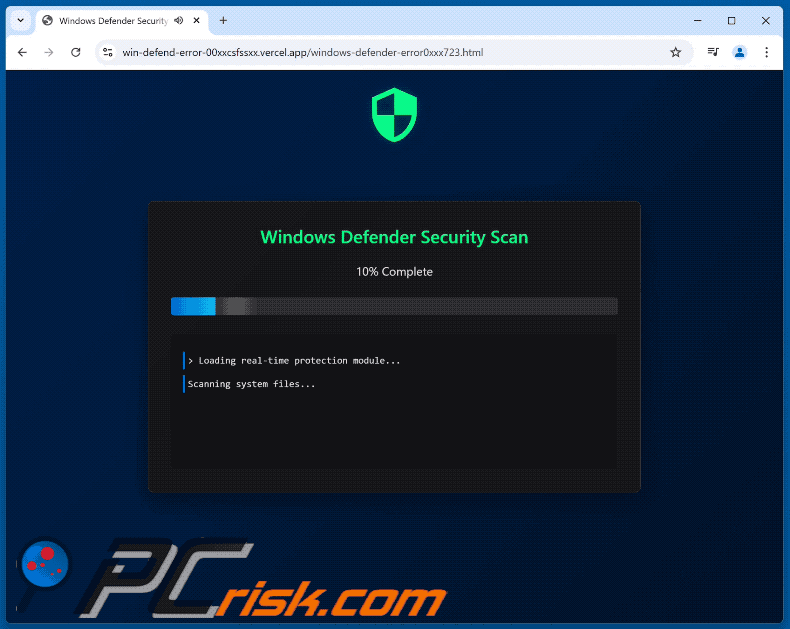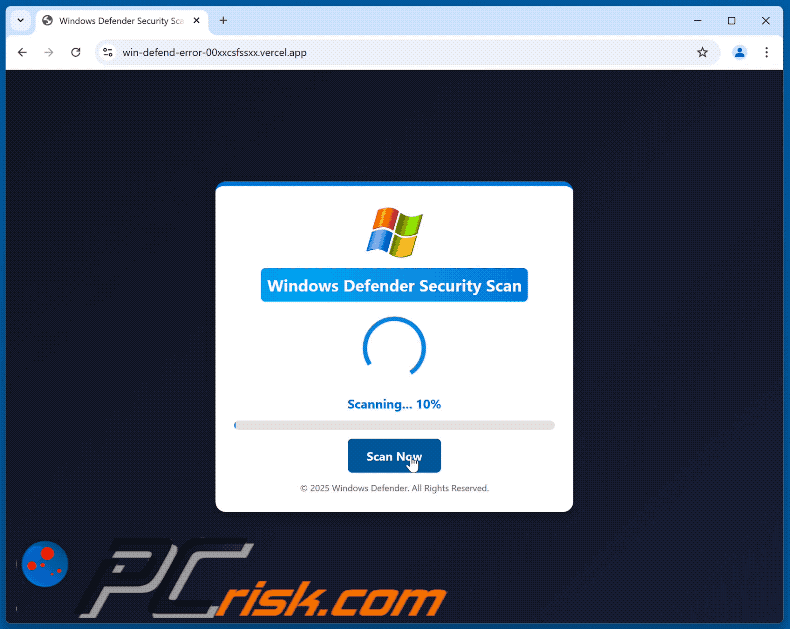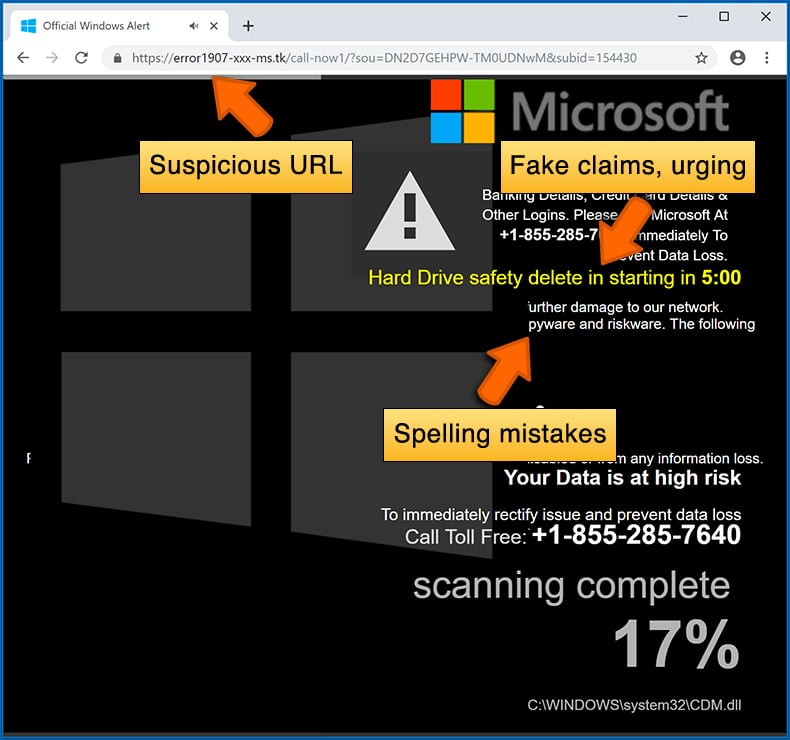How to identify scams like "Windows Defender Security Scan"
Phishing/ScamAlso Known As: "Windows Defender Security Scan" pop-up
Get free scan and check if your device is infected.
Remove it nowTo use full-featured product, you have to purchase a license for Combo Cleaner. Seven days free trial available. Combo Cleaner is owned and operated by RCS LT, the parent company of PCRisk.com.
What kind of scam is "Windows Defender Security Scan"?
"Windows Defender Security Scan" is a technical support scam with several appearance variants. The key points include a fake system scan detecting threats and encouragement for users to call a likewise bogus helpline. Once phoned, scammers can entangle victims in a scheme that poses severe threats.
It must be emphasized that this scam is not associated with any Windows products/services or their developer – the Microsoft Corporation.

"Windows Defender Security Scan" scam overview
Once a website hosting this scam is accessed, it presents the visitor with the Microsoft Defender Antivirus (referred to throughout the scam by its former name – "Windows Defender") that runs a scan of the visitor's computer. It detects serious issues on the system (e.g., "network breach", "compromised network theft", etc.) and warns the user of associated threats. The scam urges the visitor to call the provided support line to address the issues.
It must be reiterated that all the claims made by this scam are false; in fact, no website can detect threats on visitors' devices. It must also be stressed that this content is in no way linked to Microsoft.
This is a tech support scam. Typically, once called, scammers (who pretend to be "support", "Microsoft-certified technicians", etc.) request to access callers' devices remotely. Access can be established using legitimate programs like UltraViewer, TeamViewer, or others. How the scam progresses after that point can differ considerably but poses significant dangers regardless.
Threats posed by tech support scammers
When cyber criminals connect to victims' computers, they can remove genuine security tools, download/install fake anti-viruses, obtain sensitive data, extract funds, and cause malware infections (e.g., trojans, ransomware, etc.).
Information can be acquired by tricking callers into disclosing it over the phone or entering it into phishing websites/files. It can be exfiltrated using information-stealing malware as well. Targeted data can include log-in credentials (emails, social media, e-commerce, online banking, digital wallets, etc.), personally identifiable information (ID card details, passport scans/photos, etc.), and finance-related data (credit/debit card numbers, etc.).
"Services" provided by scammers tend to be exorbitantly priced. Cyber criminals often ask for payments to be made using difficult-to-trace and reverse methods like gift cards, cryptocurrencies, or cash hidden in packages and shipped.
Detailed information on technical support scams (i.e., identification, modus operandi, goals, threats, etc.) can be found in our dedicated article.
In summary, by trusting a scam like "Windows Defender Security Scan" – users can experience system infections, severe privacy issues, financial losses, and identity theft.
If you find it impossible to close a deceptive webpage – end the browser's process using Task Manager. Remember that restoring the previous browsing session will reopen the scam page; therefore, begin a new one when reaccessing the browser.
If you have allowed scammers to access your device remotely – disconnect it from the Internet. Afterward, uninstall the remote access software used, as cyber criminals might not need your consent to reconnect. Lastly, perform a complete system scan with an anti-virus and eliminate all detected threats.
| Name | "Windows Defender Security Scan" pop-up |
| Threat Type | Phishing, Scam, Social Engineering, Fraud |
| Fake Claim | Visitor's computer is at great risk (e.g., compromised/breached network, etc.). |
| Disguise | Microsoft |
| Tech Support Scammer Phone Number | +1-800-555-0199, +1 (800) 900-9990 |
| Symptoms | Fake error messages, fake system warnings, pop-up errors, hoax computer scan. |
| Distribution methods | Compromised websites, rogue online pop-up ads, potentially unwanted applications. |
| Damage | Loss of sensitive private information, monetary loss, identity theft, possible malware infections. |
| Malware Removal (Windows) |
To eliminate possible malware infections, scan your computer with legitimate antivirus software. Our security researchers recommend using Combo Cleaner. Download Combo CleanerTo use full-featured product, you have to purchase a license for Combo Cleaner. 7 days free trial available. Combo Cleaner is owned and operated by RCS LT, the parent company of PCRisk.com. |
Technical support scam examples
"We Are Having Trouble With Firewall", "(5) Virus/Malware infections have been detected", "Virus Alert (05261)", and "Error Updating Software: #009292w099738H98" are merely some of our latest articles on tech support scams.
The Internet is rife with deceptive and malicious content. Online scams use various lures, e.g., system infections, security concerns, software upgrades, account issues, giveaways, lotteries, and so forth. Due to how widespread scams are on the Web and how well-made they can be – we highly recommend exercising caution when browsing.
How did I open a scam website?
The most prevalent scam promotion techniques include: websites that use rogue advertising networks, spam (e.g., emails, SMSes, cold calls/ robocalls, browser notifications, DMs/PMs, etc.), intrusive advertisements, misspelled URLs (typosquatting), and adware.
How to avoid visiting scam websites?
Caution is essential to device and user safety. Hence, be wary of websites/ads/messages/calls that warn of terrible dangers or make promises that sound too good to be true. Do not use websites offering pirated content or other questionable services (e.g., illegal streaming/downloading, Torrenting, etc.), as these webpages are typically monetized through rogue advertising networks.
Take note of URLs and type them carefully. Treat incoming mail with vigilance; do not open attachments or links present in suspicious emails/messages. Do not permit dubious pages to deliver browser notifications; ignore or deny their requests (i.e., click "Block", "Block Notifications", etc.).
Download from official/verified channels and be attentive when installing (e.g., study terms and options, use "Custom/Advanced" settings, and opt out of additional apps, extensions, etc.) – to prevent bundled/harmful software from infiltrating the system.
If your computer is already infected, we recommend running a scan with Combo Cleaner Antivirus for Windows to automatically eliminate all threats.
Text presented in "Windows Defender Security Scan" pop-up:
Windows Defender Security Scan
CRITICAL SYSTEM ALERT: NETWORK BREACH DETECTED
Immediate action required to prevent data loss
Contact Microsoft Security team: +1-800-555-0199
Appearance of the "Windows Defender Security Scan" pop-up scam (GIF):

Another appearance of the "Windows Defender Security Scan" pop-up scam (GIF):

Text presented in the pop-up displayed by this variant:
Windows Defender Security Scan
Compromised Network Theft Detected! Immediate action required.
Call Microsoft Toll Free Helpline USA/CA: +1 (800) 900-9990
DO NOT TURN OFF OR RESTART YOUR DEVICE or you might lose all files, data, and documents on your PC/laptop, causing corruption or even a crash! Immediately call Microsoft Geeks for assistance with this vulnerability.
Instant automatic malware removal:
Manual threat removal might be a lengthy and complicated process that requires advanced IT skills. Combo Cleaner is a professional automatic malware removal tool that is recommended to get rid of malware. Download it by clicking the button below:
DOWNLOAD Combo CleanerBy downloading any software listed on this website you agree to our Privacy Policy and Terms of Use. To use full-featured product, you have to purchase a license for Combo Cleaner. 7 days free trial available. Combo Cleaner is owned and operated by RCS LT, the parent company of PCRisk.com.
Quick menu:
- What is "Windows Defender Security Scan" pop-up?
- How to identify a pop-up scam?
- How do pop-up scams work?
- How to remove fake pop-ups?
- How to prevent fake pop-ups?
- What to do if you fell for a pop-up scam?
How to identify a pop-up scam?
Pop-up windows with various fake messages are a common type of lures cybercriminals use. They collect sensitive personal data, trick Internet users into calling fake tech support numbers, subscribe to useless online services, invest in shady cryptocurrency schemes, etc.
While in the majority of cases these pop-ups don't infect users' devices with malware, they can cause direct monetary loss or could result in identity theft.
Cybercriminals strive to create their rogue pop-up windows to look trustworthy, however, scams typically have the following characteristics:
- Spelling mistakes and non-professional images - Closely inspect the information displayed in a pop-up. Spelling mistakes and unprofessional images could be a sign of a scam.
- Sense of urgency - Countdown timer with a couple of minutes on it, asking you to enter your personal information or subscribe to some online service.
- Statements that you won something - If you haven't participated in a lottery, online competition, etc., and you see a pop-up window stating that you won.
- Computer or mobile device scan - A pop-up window that scans your device and informs of detected issues - is undoubtedly a scam; webpages cannot perform such actions.
- Exclusivity - Pop-up windows stating that only you are given secret access to a financial scheme that can quickly make you rich.
Example of a pop-up scam:

How do pop-up scams work?
Cybercriminals and deceptive marketers usually use various advertising networks, search engine poisoning techniques, and shady websites to generate traffic to their pop-ups. Users land on their online lures after clicking on fake download buttons, using a torrent website, or simply clicking on an Internet search engine result.
Based on users' location and device information, they are presented with a scam pop-up. Lures presented in such pop-ups range from get-rich-quick schemes to fake virus scans.
How to remove fake pop-ups?
In most cases, pop-up scams do not infect users' devices with malware. If you encountered a scam pop-up, simply closing it should be enough. In some cases scam, pop-ups may be hard to close; in such cases - close your Internet browser and restart it.
In extremely rare cases, you might need to reset your Internet browser. For this, use our instructions explaining how to reset Internet browser settings.
How to prevent fake pop-ups?
To prevent seeing pop-up scams, you should visit only reputable websites. Torrent, Crack, free online movie streaming, YouTube video download, and other websites of similar reputation commonly redirect Internet users to pop-up scams.
To minimize the risk of encountering pop-up scams, you should keep your Internet browsers up-to-date and use reputable anti-malware application. For this purpose, we recommend Combo Cleaner Antivirus for Windows.
What to do if you fell for a pop-up scam?
This depends on the type of scam that you fell for. Most commonly, pop-up scams try to trick users into sending money, giving away personal information, or giving access to one's device.
- If you sent money to scammers: You should contact your financial institution and explain that you were scammed. If informed promptly, there's a chance to get your money back.
- If you gave away your personal information: You should change your passwords and enable two-factor authentication in all online services that you use. Visit Federal Trade Commission to report identity theft and get personalized recovery steps.
- If you let scammers connect to your device: You should scan your computer with reputable anti-malware (we recommend Combo Cleaner Antivirus for Windows) - cyber criminals could have planted trojans, keyloggers, and other malware, don't use your computer until removing possible threats.
- Help other Internet users: report Internet scams to Federal Trade Commission.
Frequently Asked Questions (FAQ)
What is a pop-up scam?
Basically, pop-up scams are deceptive messages aiming to trick users into performing specific actions. For example, victims can be deceived into calling fake helplines, allowing scammers to access computers remotely, disclosing vulnerable information, sending money to criminals, downloading/installing programs, purchasing products, subscribing to services, and so forth.
What is the purpose of a pop-up scam?
Pop-up scams are designed to generate revenue at victims' expense. Scammers can profit by acquiring funds through deception, endorsing content (e.g., websites, programs, products, services, etc.), selling/abusing private data, and spreading malware.
Why do I encounter fake pop-ups?
Pop-up scams are mainly endorsed via spam (e.g., emails, calls, SMSes, PMs/DMs, browser notifications, etc.), webpages using rogue advertising networks, intrusive ads (malvertising), mistyped URLs (typosquatting), and adware.
I cannot exit a scam page, how do I close it?
If you cannot exit a scam page – you have to end the browser's process using Task Manager. Remember to start a new browsing session when relaunching the browser, as the previous one includes the deceptive site.
I have allowed cyber criminals to remotely access my computer, what should I do?
If you have allowed cyber criminals to access your computer remotely – you must first disconnect it from the Internet. Secondly, uninstall the remote access program that the scammers used, as they might not need your permission to reconnect. Lastly, run a complete system scan with an anti-virus and remove all detected threats.
I have provided my personal information when tricked by a pop-up scam, what should I do?
If you have provided your log-in credentials – change the passwords of all possibly exposed accounts and inform their official support without delay. However, if the disclosed information was of a different personal nature (e.g., ID card details, credit card numbers, etc.) – immediately contact the corresponding authorities.
Will Combo Cleaner protect me from pop-up scams and the malware they proliferate?
Combo Cleaner can scan visited websites for deceptive/malicious content and restrict further access to them. Additionally, Combo Cleaner can detect and remove most of the known malware infections. Keep in mind that performing a full system scan is crucial since high-end malicious software tends to hide deep within systems.
Share:

Tomas Meskauskas
Expert security researcher, professional malware analyst
I am passionate about computer security and technology. I have an experience of over 10 years working in various companies related to computer technical issue solving and Internet security. I have been working as an author and editor for pcrisk.com since 2010. Follow me on Twitter and LinkedIn to stay informed about the latest online security threats.
PCrisk security portal is brought by a company RCS LT.
Joined forces of security researchers help educate computer users about the latest online security threats. More information about the company RCS LT.
Our malware removal guides are free. However, if you want to support us you can send us a donation.
DonatePCrisk security portal is brought by a company RCS LT.
Joined forces of security researchers help educate computer users about the latest online security threats. More information about the company RCS LT.
Our malware removal guides are free. However, if you want to support us you can send us a donation.
Donate
▼ Show Discussion